Artificial Intelligence (AI) Market In Healthcare Size 2025-2029
The artificial intelligence (AI) market in healthcare size is valued to increase USD 30.23 billion, at a CAGR of 33.1% from 2024 to 2029. Push for digitization in healthcare will drive the artificial intelligence (AI) market in healthcare.
Major Market Trends & Insights
- North America dominated the market and accounted for a 38% growth during the forecast period.
- By Application - Medical imaging and diagnostics segment was valued at USD 1.52 billion in 2023
- By Component - Software segment accounted for the largest market revenue share in 2023
Market Size & Forecast
- Market Opportunities: USD 961.16 million
- Market Future Opportunities: USD 30230.60 million
- CAGR : 33.1%
- North America: Largest market in 2023
Market Summary
- The market is a dynamic and rapidly evolving sector, driven by advancements in core technologies such as machine learning and natural language processing. These technologies are revolutionizing healthcare delivery through applications like predictive analytics, medical imaging, and virtual nursing assistants. According to recent reports, the global AI in healthcare market is expected to reach a significant market share by 2027, growing at a steady pace due to increasing adoption rates and the need for digitization in healthcare. For instance, AI-based tools are increasingly being used to improve elderly care, with applications ranging from fall detection to medication management.
- However, challenges such as physician and provider skepticism, data privacy concerns, and regulatory issues persist. Despite these challenges, the opportunities for AI in healthcare are vast, with potential applications in disease diagnosis, treatment planning, and population health management.
What will be the Size of the Artificial Intelligence (AI) Market In Healthcare during the forecast period?
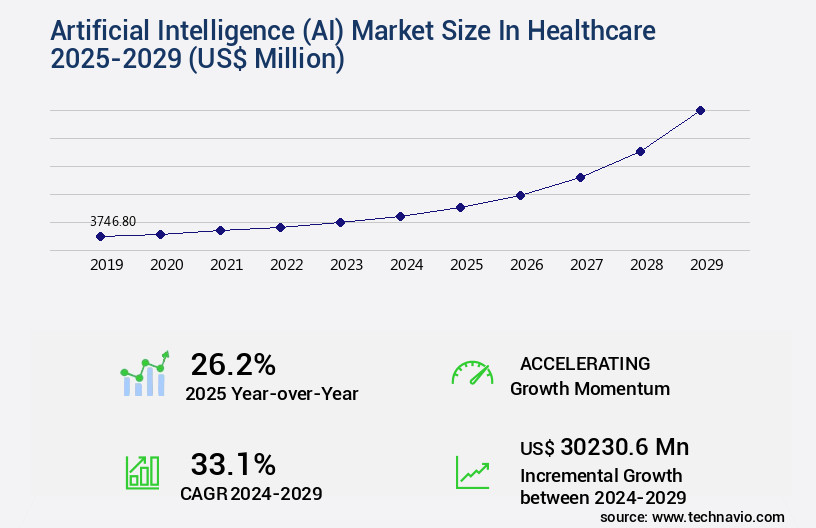
Get Key Insights on Market Forecast (PDF) Request Free Sample
How is the Artificial Intelligence (AI) In Healthcare Market Segmented and what are the key trends of market segmentation?
The artificial intelligence (AI) in healthcare industry research report provides comprehensive data (region-wise segment analysis), with forecasts and estimates in "USD million" for the period 2025-2029, as well as historical data from 2019-2023 for the following segments.
- Application
- Medical imaging and diagnostics
- Drug discovery
- Virtual assistants
- Operations management
- Others
- Component
- Software
- Hardware
- Services
- End-user
- Hospitals and clinics
- Research institutes and academies
- Geography
- North America
- Europe
- APAC
- South America
- Rest of World (ROW)
By Application Insights
The medical imaging and diagnostics segment is estimated to witness significant growth during the forecast period.
Artificial Intelligence (AI) is revolutionizing the healthcare sector by enhancing various applications, from treatment optimization and diagnostics to patient engagement and fraud detection. Natural language processing and machine learning algorithms enable AI-powered virtual assistants to assist in clinical decision support, while computer vision systems analyze medical images for disease prediction and radiation therapy planning. Genomic data analysis and drug discovery platforms leverage AI to uncover new insights and accelerate research. Data mining techniques and predictive modeling are crucial for risk stratification and clinical trial optimization, while deep learning models improve healthcare chatbots and robotic surgery systems' precision.
The market for AI in healthcare is expanding rapidly, with remote patient monitoring and AI-powered diagnostics witnessing significant growth. According to recent studies, the market for AI in healthcare is projected to reach 61.2 billion USD by 2026, representing a 41.5% increase from its current size. Additionally, the adoption of AI in healthcare is expected to grow by 38.2% in the next five years. AI's impact on healthcare is multifaceted, from improving patient outcomes and reducing costs to enhancing operational efficiency and enabling personalized medicine. Wearable sensor data and electronic health records are essential data sources for AI applications in healthcare, while healthcare data interoperability and big data analytics are crucial for driving innovation and improving patient care.
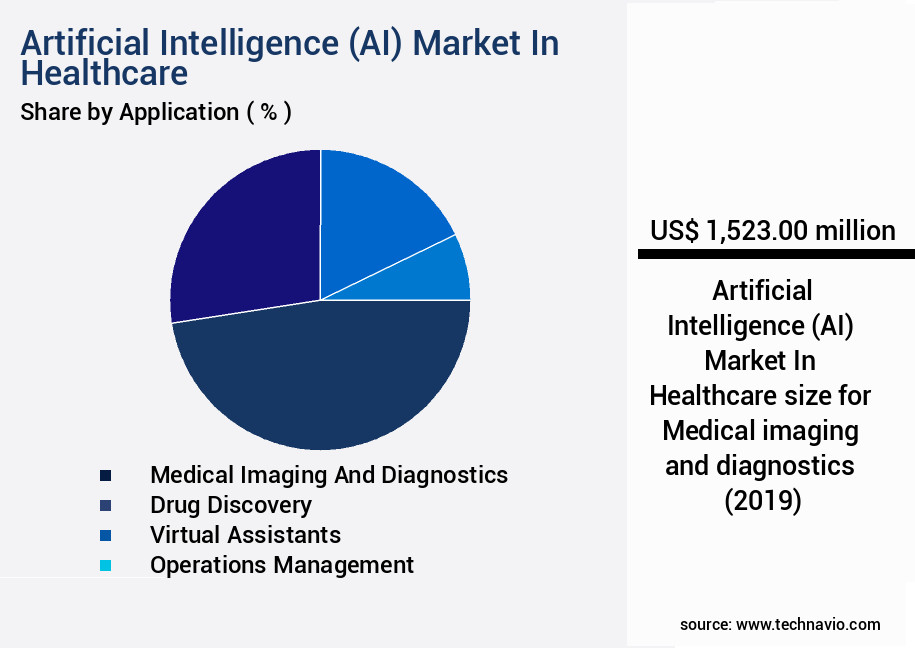
Request Free Sample
The Medical imaging and diagnostics segment was valued at USD 1.52 billion in 2019 and showed a gradual increase during the forecast period.
AI's role in healthcare is continuously evolving, with ongoing developments in precision oncology, disease prediction models, and drug repurposing. AI-powered fraud detection systems and biometric authentication further strengthen the security and privacy of patient data. Telemedicine platforms and clinical decision support systems are essential tools for healthcare providers in the era of AI, enabling remote consultations and evidence-based diagnoses.
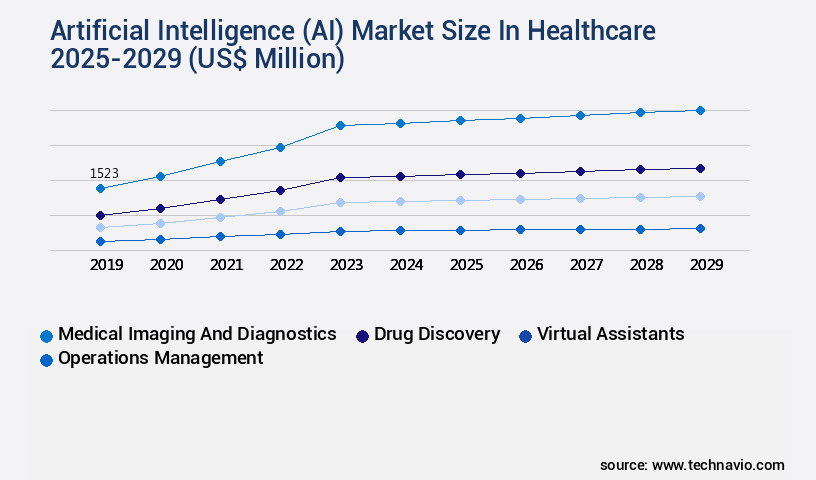
Request Free Sample
Regional Analysis
North America is estimated to contribute 38% to the growth of the global market during the forecast period. Technavio's analysts have elaborately explained the regional trends and drivers that shape the market during the forecast period.
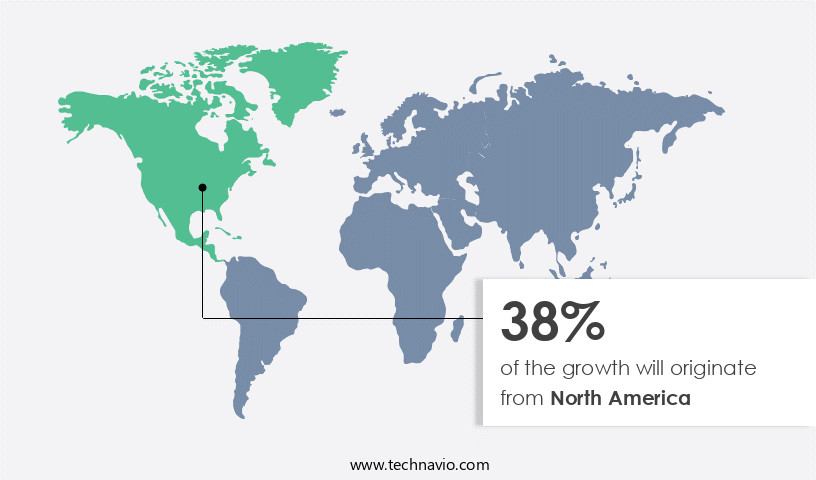
See How Artificial Intelligence (AI) In Healthcare Market Demand is Rising in North America Request Free Sample
The healthcare sector in North America, home to technologically advanced economies like the US and Canada, experiences significant infrastructure development, fueling the growth of the AI market. With early technology adoption and substantial investments from industry leaders such as Microsoft, Google, and IBM, the demand for AI solutions in this region continues to escalate. The US, in particular, leads globally in AI patent filings, further underscoring its commitment to AI innovation.
As a professional, I can provide you with more detailed insights into the evolving AI landscape within the North American healthcare sector.
Market Dynamics
Our researchers analyzed the data with 2024 as the base year, along with the key drivers, trends, and challenges. A holistic analysis of drivers will help companies refine their marketing strategies to gain a competitive advantage.
The market is experiencing rapid growth as technology advances and healthcare providers seek to enhance patient care and efficiency. Deep learning for medical image classification is revolutionizing diagnostics, enabling more accurate and timely diagnoses. In contrast, natural language processing in healthcare chatbots is streamlining patient communication and improving access to care. AI-powered diagnostic tools for early disease detection, utilizing machine learning algorithms, are increasingly popular. These tools analyze vast amounts of data to identify patterns and trends, enabling early intervention and better patient outcomes. Computer vision for robotic surgery assistance and predictive modeling for patient risk stratification are also gaining traction, offering significant benefits in precision and cost savings.
Genomic data analysis for precision oncology and wearable sensor data for remote patient monitoring are transforming personalized medicine. Big data analytics for healthcare cost reduction and AI-driven drug discovery and development are also driving innovation, with significant potential to reduce costs and improve patient outcomes. Clinical decision support systems for improved outcomes, patient engagement tools for better adherence, telemedicine platforms for remote consultations, and explainable AI models for healthcare transparency are all essential components of the AI-driven healthcare landscape. The regulatory approval process for AI-based medical devices poses a challenge, but implementation strategies for AI in healthcare systems are being developed.
Cost-effectiveness analysis of AI-driven healthcare solutions is crucial, with more than 60% of healthcare organizations reporting cost savings from AI implementation. Clinical validation of AI algorithms for improved accuracy is a priority, with a growing number of studies demonstrating the benefits of AI in healthcare. Ethical considerations and responsible AI development are also critical, as the healthcare sector navigates the complexities of AI integration. Compared to traditional healthcare methods, AI-driven solutions offer significant advantages in terms of accuracy, efficiency, and patient engagement. The potential for AI to revolutionize healthcare is vast, with numerous applications and benefits yet to be realized.
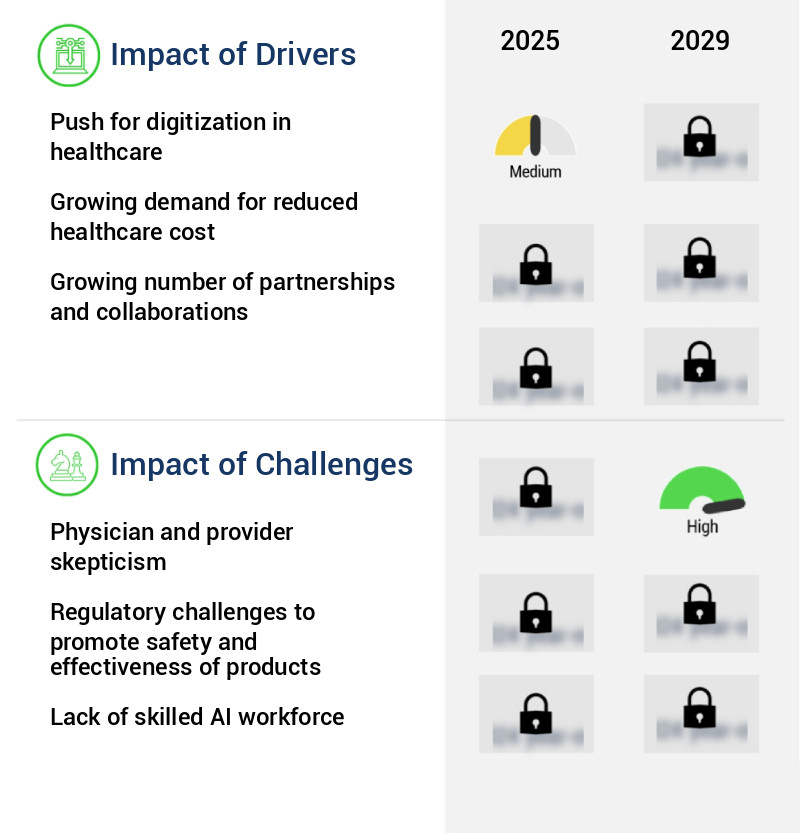
What are the key market drivers leading to the rise in the adoption of Artificial Intelligence (AI) In Healthcare Industry?
- The push for digitization in healthcare serves as the primary market driver, transforming the industry through advanced technologies such as electronic health records, telemedicine, and artificial intelligence.
- The global healthcare sector is experiencing a digital transformation, fueled by the expanding reach of IT-integrated processes. Connected healthcare, enabled by smartphones and the growing Internet penetration worldwide, streamlines healthcare delivery and facilitates secure patient data management. This transition generates new revenue opportunities for stakeholders. The adoption of advanced technologies like AI, augmented reality, and advanced analytics is accelerated by offering connected healthcare services via digital platforms, such as wearable devices and sensors. A significant milestone in this digital revolution is the shift from paper-based healthcare records to Electronic Health Records (EHRs).
- This transformation simplifies healthcare administration, enhances patient care, and paves the way for further innovation. The digitalization of healthcare is a continuous process, with ongoing activities and evolving patterns shaping its landscape.
What are the market trends shaping the Artificial Intelligence (AI) In Healthcare Industry?
- The emerging trend in elderly care is the new growing potential for AI-based tools. These advanced technologies are increasingly being utilized in this sector.
- The global aging population is experiencing a significant expansion, with the number of individuals aged 60 and above projected to rise from approximately 605 million in 2000 to nearly 2 billion by 2050. Europe, Japan, and China are witnessing the most substantial growth in this demographic segment. In the United States, the elderly population is anticipated to comprise around 20% of the total population by 2030.
- This demographic shift holds potential implications for economic, social, and health aspects of various economies. Consequently, there is a pressing need for innovative healthcare delivery systems catering to the unique requirements of the geriatric population.
What challenges does the Artificial Intelligence (AI) In Healthcare Industry face during its growth?
- The growth of the healthcare industry is significantly influenced by the skepticism exhibited by physicians and providers towards new innovations and approaches. This reluctance poses a significant challenge that must be addressed for the industry to progress and evolve.
- The integration of AI in healthcare is revolutionizing patient care through connected healthcare services. The healthcare sector faces a significant shortage of medical professionals, fueling the adoption of AI as a potential solution. Despite the anticipated disruption, a considerable number of doctors remain skeptical about AI's role. AI brings several benefits, including enhanced diagnostics and enabling physicians to focus on critical health issues and high-risk patients.
- However, the implementation of AI-based healthcare solutions remains in its developmental phase, yet to significantly impact mainstream physician practice. Technology and life sciences companies must prioritize delivering superior user experiences and innovative product offerings to maximize the value of AI in healthcare.
Exclusive Technavio Analysis on Customer Landscape
The artificial intelligence (AI) market in healthcare forecasting report includes the adoption lifecycle of the market, covering from the innovator's stage to the laggard's stage. It focuses on adoption rates in different regions based on penetration. Furthermore, the artificial intelligence (AI) market in healthcare report also includes key purchase criteria and drivers of price sensitivity to help companies evaluate and develop their market growth analysis strategies.
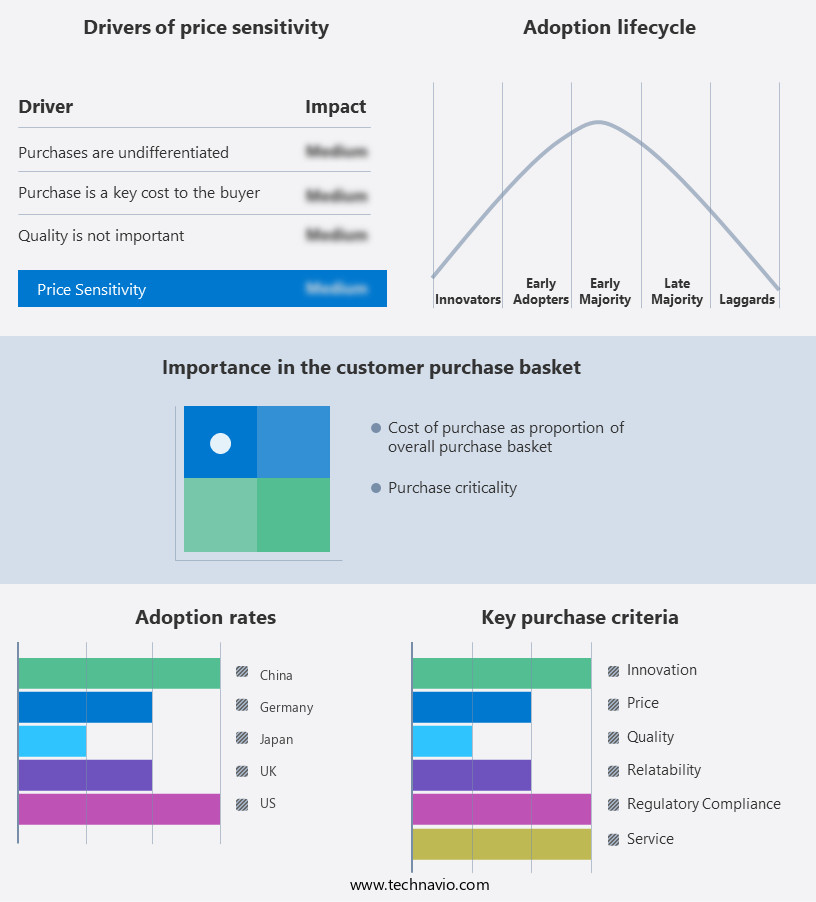
Customer Landscape of Artificial Intelligence (AI) In Healthcare Industry
Competitive Landscape
Companies are implementing various strategies, such as strategic alliances, artificial intelligence (ai) market in healthcare forecast, partnerships, mergers and acquisitions, geographical expansion, and product/service launches, to enhance their presence in the industry.
Ada Health GmbH - The healthcare sector experiences significant advancements through the integration of artificial intelligence (AI), with companies like Ada leading the way.
The industry research and growth report includes detailed analyses of the competitive landscape of the market and information about key companies, including:
- Ada Health GmbH
- Aidoc
- Aiforia Technologies PLC
- Amazon.com Inc.
- Atomwise Inc.
- BenchSci Analytics Inc.
- CarePredict Inc.
- Catalia Health
- Deep Genomics Inc.
- Entelai
- GE Healthcare Technologies Inc.
- Google LLC
- Intel Corp.
- International Business Machines Corp.
- Koninklijke Philips NV
- Medtronic Plc
- Microsoft Corp.
- NVIDIA Corp.
- Recursion Pharmaceuticals Inc.
- Siemens Healthineers AG
Qualitative and quantitative analysis of companies has been conducted to help clients understand the wider business environment as well as the strengths and weaknesses of key industry players. Data is qualitatively analyzed to categorize companies as pure play, category-focused, industry-focused, and diversified; it is quantitatively analyzed to categorize companies as dominant, leading, strong, tentative, and weak.
Recent Development and News in Artificial Intelligence (AI) Market In Healthcare
- In January 2024, IBM Watson Health announced the FDA clearance for its AI-powered diagnostic tool, IBM Watson for Clinical Trial Matching. This solution uses AI algorithms to identify eligible patients for clinical trials based on their electronic health records (EHRs), aiming to expedite the trial recruitment process and improve patient outcomes (IBM Press Release, 2024).
- In March 2024, Google's DeepMind Health and the UK's National Health Service (NHS) signed a landmark partnership to deploy Streams, an AI-powered app, in 17 hospitals across England. Streams monitors patients with acute kidney injury and alerts clinicians in real-time, reducing response times and potentially saving lives (Google DeepMind, 2024).
- In May 2024, Microsoft and AdventHealth, a leading US healthcare provider, announced a strategic collaboration to deploy Microsoft's Azure AI platform for clinical research and patient care. This partnership aims to improve patient outcomes through AI-powered insights from EHRs and telemedicine services (Microsoft News Center, 2024).
- In April 2025, Amazon Web Services (AWS) and Medtronic, a global healthcare technology company, announced a multi-year agreement to deploy AWS AI and machine learning (ML) services to optimize Medtronic's medical devices and healthcare operations. This collaboration aims to enhance patient care and operational efficiency (AWS Press Release, 2025).
Dive into Technavio's robust research methodology, blending expert interviews, extensive data synthesis, and validated models for unparalleled Artificial Intelligence (AI) Market In Healthcare insights. See full methodology.
|
Market Scope
|
|
Report Coverage
|
Details
|
|
Page number
|
234
|
|
Base year
|
2024
|
|
Historic period
|
2019-2023 |
|
Forecast period
|
2025-2029
|
|
Growth momentum & CAGR
|
Accelerate at a CAGR of 33.1%
|
|
Market growth 2025-2029
|
USD 30230.6 million
|
|
Market structure
|
Fragmented
|
|
YoY growth 2024-2025(%)
|
26.2
|
|
Key countries
|
US, Canada, Germany, China, UK, Japan, France, Brazil, India, and Italy
|
|
Competitive landscape
|
Leading Companies, Market Positioning of Companies, Competitive Strategies, and Industry Risks
|
Request Free Sample
Research Analyst Overview
- Artificial Intelligence (AI) continues to revolutionize the healthcare industry, with various applications reshaping treatment optimization, diagnosis, and patient care. Natural Language Processing (NLP) enables more accurate and efficient analysis of medical records, while computer vision systems facilitate medical image analysis, enhancing diagnostic accuracy. Virtual assistants and chatbots streamline patient engagement and monitoring, offering personalized care and support. AI-powered diagnostics and risk stratification models improve clinical decision-making, ensuring timely and effective interventions. Genomic data analysis, fueled by data mining techniques, uncovers new insights into disease mechanisms and treatment options. AI-driven drug discovery platforms and precision oncology harness the power of machine learning algorithms to identify potential drugs and personalized treatment plans.
- Predictive modeling and clinical trial optimization accelerate research, reducing costs and increasing efficiency. Remote patient monitoring and wearable sensor data provide real-time health information, enabling early intervention and improved patient outcomes. Deep learning models and robotics surgery systems offer enhanced surgical precision and safety. Health data interoperability, facilitated by AI, ensures seamless information exchange between healthcare providers, improving overall patient care. Big data analytics and fraud detection systems safeguard against financial losses and ensure regulatory compliance. In the realm of disease prediction models, AI-driven approaches outperform traditional methods, enabling early intervention and more effective treatment strategies.
- Radiation therapy planning and electronic health records further optimize patient care, enhancing overall healthcare delivery. Telemedicine platforms and biometric authentication systems expand access to healthcare services, ensuring patients receive the care they need, regardless of location or physical limitations. The AI market in healthcare continues to evolve, with ongoing advancements and innovations transforming the industry landscape.
What are the Key Data Covered in this Artificial Intelligence (AI) Market In Healthcare Research and Growth Report?
-
What is the expected growth of the Artificial Intelligence (AI) Market In Healthcare between 2025 and 2029?
-
What segmentation does the market report cover?
-
The report segmented by Application (Medical imaging and diagnostics, Drug discovery, Virtual assistants, Operations management, and Others), Component (Software, Hardware, and Services), End-user (Hospitals and clinics and Research institutes and academies), and Geography (North America, Europe, APAC, South America, and Middle East and Africa)
-
Which regions are analyzed in the report?
-
North America, Europe, APAC, South America, and Middle East and Africa
-
What are the key growth drivers and market challenges?
-
Who are the major players in the Artificial Intelligence (AI) Market In Healthcare?
-
Key Companies Ada Health GmbH, Aidoc, Aiforia Technologies PLC, Amazon.com Inc., Atomwise Inc., BenchSci Analytics Inc., CarePredict Inc., Catalia Health, Deep Genomics Inc., Entelai, GE Healthcare Technologies Inc., Google LLC, Intel Corp., International Business Machines Corp., Koninklijke Philips NV, Medtronic Plc, Microsoft Corp., NVIDIA Corp., Recursion Pharmaceuticals Inc., and Siemens Healthineers AG
Market Research Insights
- The market is experiencing significant growth. This expansion is driven by the increasing adoption of AI technologies, such as convolutional neural networks and recurrent neural networks, in various healthcare applications. For instance, AI algorithms are being used for medical image registration, image segmentation, and object detection in radiology, leading to improved diagnostic accuracy and efficiency. However, the integration of AI in healthcare also presents challenges. Data privacy regulations, such as GDPR compliance and HIPAA compliance, are crucial considerations to ensure patient data security.
- Moreover, explainable AI and model interpretability are essential for understanding and addressing algorithm bias and ethical concerns. With the implementation of AI in patient portals and health information exchange, regulatory approval and cost-effectiveness analysis are crucial to ensure the long-term success and sustainability of these initiatives. Despite these challenges, the benefits of AI in healthcare, including enhanced patient care and improved clinical outcomes, far outweigh the obstacles.
We can help! Our analysts can customize this artificial intelligence (AI) market in healthcare research report to meet your requirements.
Get in touch
1 Executive Summary
- 1.1 Market overview
- Executive Summary - Chart on Market Overview
- Executive Summary - Data Table on Market Overview
- Executive Summary - Chart on Global Market Characteristics
- Executive Summary - Chart on Market by Geography
- Executive Summary - Chart on Market Segmentation by Application
- Executive Summary - Chart on Market Segmentation by Component
- Executive Summary - Chart on Market Segmentation by End-user
- Executive Summary - Chart on Incremental Growth
- Executive Summary - Data Table on Incremental Growth
- Executive Summary - Chart on Company Market Positioning
2 Technavio Analysis
- 2.1 Analysis of price sensitivity, lifecycle, customer purchase basket, adoption rates, and purchase criteria
- Analysis of price sensitivity, lifecycle, customer purchase basket, adoption rates, and purchase criteria
- 2.2 Criticality of inputs and Factors of differentiation
- Overview on criticality of inputs and factors of differentiation
- 2.3 Factors of disruption
- Overview on factors of disruption
- 2.4 Impact of drivers and challenges
- Impact of drivers and challenges in 2024 and 2029
3 Market Landscape
- 3.1 Market ecosystem
- Parent Market
- Data Table on - Parent Market
- 3.2 Market characteristics
- Market characteristics analysis
4 Market Sizing
- 4.1 Market definition
- Offerings of companies included in the market definition
- 4.2 Market segment analysis
- 4.4 Market outlook: Forecast for 2024-2029
- Chart on Global - Market size and forecast 2024-2029 ($ million)
- Data Table on Global - Market size and forecast 2024-2029 ($ million)
- Chart on Global Market: Year-over-year growth 2024-2029 (%)
- Data Table on Global Market: Year-over-year growth 2024-2029 (%)
5 Historic Market Size
- 5.1 Global Artificial Intelligence (AI) Market In Healthcare 2019 - 2023
- Historic Market Size - Data Table on Global Artificial Intelligence (AI) Market In Healthcare 2019 - 2023 ($ million)
- 5.2 Application segment analysis 2019 - 2023
- Historic Market Size - Application Segment 2019 - 2023 ($ million)
- 5.3 Component segment analysis 2019 - 2023
- Historic Market Size - Component Segment 2019 - 2023 ($ million)
- 5.4 End-user segment analysis 2019 - 2023
- Historic Market Size - End-user Segment 2019 - 2023 ($ million)
- 5.5 Geography segment analysis 2019 - 2023
- Historic Market Size - Geography Segment 2019 - 2023 ($ million)
- 5.6 Country segment analysis 2019 - 2023
- Historic Market Size - Country Segment 2019 - 2023 ($ million)
6 Qualitative Analysis
- 6.1 Impact of AI on Global Artificial Intelligence (AI) Market in Healthcare
7 Five Forces Analysis
- 7.1 Five forces summary
- Five forces analysis - Comparison between 2024 and 2029
- 7.2 Bargaining power of buyers
- Bargaining power of buyers - Impact of key factors 2024 and 2029
- 7.3 Bargaining power of suppliers
- Bargaining power of suppliers - Impact of key factors in 2024 and 2029
- 7.4 Threat of new entrants
- Threat of new entrants - Impact of key factors in 2024 and 2029
- 7.5 Threat of substitutes
- Threat of substitutes - Impact of key factors in 2024 and 2029
- 7.6 Threat of rivalry
- Threat of rivalry - Impact of key factors in 2024 and 2029
- 7.7 Market condition
- Chart on Market condition - Five forces 2024 and 2029
8 Market Segmentation by Application
- 8.1 Market segments
- Chart on Application - Market share 2024-2029 (%)
- Data Table on Application - Market share 2024-2029 (%)
- 8.2 Comparison by Application
- Chart on Comparison by Application
- Data Table on Comparison by Application
- 8.3 Medical imaging and diagnostics - Market size and forecast 2024-2029
- Chart on Medical imaging and diagnostics - Market size and forecast 2024-2029 ($ million)
- Data Table on Medical imaging and diagnostics - Market size and forecast 2024-2029 ($ million)
- Chart on Medical imaging and diagnostics - Year-over-year growth 2024-2029 (%)
- Data Table on Medical imaging and diagnostics - Year-over-year growth 2024-2029 (%)
- 8.4 Drug discovery - Market size and forecast 2024-2029
- Chart on Drug discovery - Market size and forecast 2024-2029 ($ million)
- Data Table on Drug discovery - Market size and forecast 2024-2029 ($ million)
- Chart on Drug discovery - Year-over-year growth 2024-2029 (%)
- Data Table on Drug discovery - Year-over-year growth 2024-2029 (%)
- 8.5 Virtual assistants - Market size and forecast 2024-2029
- Chart on Virtual assistants - Market size and forecast 2024-2029 ($ million)
- Data Table on Virtual assistants - Market size and forecast 2024-2029 ($ million)
- Chart on Virtual assistants - Year-over-year growth 2024-2029 (%)
- Data Table on Virtual assistants - Year-over-year growth 2024-2029 (%)
- 8.6 Operations management - Market size and forecast 2024-2029
- Chart on Operations management - Market size and forecast 2024-2029 ($ million)
- Data Table on Operations management - Market size and forecast 2024-2029 ($ million)
- Chart on Operations management - Year-over-year growth 2024-2029 (%)
- Data Table on Operations management - Year-over-year growth 2024-2029 (%)
- 8.7 Others - Market size and forecast 2024-2029
- Chart on Others - Market size and forecast 2024-2029 ($ million)
- Data Table on Others - Market size and forecast 2024-2029 ($ million)
- Chart on Others - Year-over-year growth 2024-2029 (%)
- Data Table on Others - Year-over-year growth 2024-2029 (%)
- 8.8 Market opportunity by Application
- Market opportunity by Application ($ million)
- Data Table on Market opportunity by Application ($ million)
9 Market Segmentation by Component
- 9.1 Market segments
- Chart on Component - Market share 2024-2029 (%)
- Data Table on Component - Market share 2024-2029 (%)
- 9.2 Comparison by Component
- Chart on Comparison by Component
- Data Table on Comparison by Component
- 9.3 Software - Market size and forecast 2024-2029
- Chart on Software - Market size and forecast 2024-2029 ($ million)
- Data Table on Software - Market size and forecast 2024-2029 ($ million)
- Chart on Software - Year-over-year growth 2024-2029 (%)
- Data Table on Software - Year-over-year growth 2024-2029 (%)
- 9.4 Hardware - Market size and forecast 2024-2029
- Chart on Hardware - Market size and forecast 2024-2029 ($ million)
- Data Table on Hardware - Market size and forecast 2024-2029 ($ million)
- Chart on Hardware - Year-over-year growth 2024-2029 (%)
- Data Table on Hardware - Year-over-year growth 2024-2029 (%)
- 9.5 Services - Market size and forecast 2024-2029
- Chart on Services - Market size and forecast 2024-2029 ($ million)
- Data Table on Services - Market size and forecast 2024-2029 ($ million)
- Chart on Services - Year-over-year growth 2024-2029 (%)
- Data Table on Services - Year-over-year growth 2024-2029 (%)
- 9.6 Market opportunity by Component
- Market opportunity by Component ($ million)
- Data Table on Market opportunity by Component ($ million)
10 Market Segmentation by End-user
- 10.1 Market segments
- Chart on End-user - Market share 2024-2029 (%)
- Data Table on End-user - Market share 2024-2029 (%)
- 10.2 Comparison by End-user
- Chart on Comparison by End-user
- Data Table on Comparison by End-user
- 10.3 Hospitals and clinics - Market size and forecast 2024-2029
- Chart on Hospitals and clinics - Market size and forecast 2024-2029 ($ million)
- Data Table on Hospitals and clinics - Market size and forecast 2024-2029 ($ million)
- Chart on Hospitals and clinics - Year-over-year growth 2024-2029 (%)
- Data Table on Hospitals and clinics - Year-over-year growth 2024-2029 (%)
- 10.4 Research institutes and academies - Market size and forecast 2024-2029
- Chart on Research institutes and academies - Market size and forecast 2024-2029 ($ million)
- Data Table on Research institutes and academies - Market size and forecast 2024-2029 ($ million)
- Chart on Research institutes and academies - Year-over-year growth 2024-2029 (%)
- Data Table on Research institutes and academies - Year-over-year growth 2024-2029 (%)
- 10.5 Market opportunity by End-user
- Market opportunity by End-user ($ million)
- Data Table on Market opportunity by End-user ($ million)
11 Customer Landscape
- 11.1 Customer landscape overview
- Analysis of price sensitivity, lifecycle, customer purchase basket, adoption rates, and purchase criteria
12 Geographic Landscape
- 12.1 Geographic segmentation
- Chart on Market share by geography 2024-2029 (%)
- Data Table on Market share by geography 2024-2029 (%)
- 12.2 Geographic comparison
- Chart on Geographic comparison
- Data Table on Geographic comparison
- 12.3 North America - Market size and forecast 2024-2029
- Chart on North America - Market size and forecast 2024-2029 ($ million)
- Data Table on North America - Market size and forecast 2024-2029 ($ million)
- Chart on North America - Year-over-year growth 2024-2029 (%)
- Data Table on North America - Year-over-year growth 2024-2029 (%)
- 12.4 Europe - Market size and forecast 2024-2029
- Chart on Europe - Market size and forecast 2024-2029 ($ million)
- Data Table on Europe - Market size and forecast 2024-2029 ($ million)
- Chart on Europe - Year-over-year growth 2024-2029 (%)
- Data Table on Europe - Year-over-year growth 2024-2029 (%)
- 12.5 APAC - Market size and forecast 2024-2029
- Chart on APAC - Market size and forecast 2024-2029 ($ million)
- Data Table on APAC - Market size and forecast 2024-2029 ($ million)
- Chart on APAC - Year-over-year growth 2024-2029 (%)
- Data Table on APAC - Year-over-year growth 2024-2029 (%)
- 12.6 South America - Market size and forecast 2024-2029
- Chart on South America - Market size and forecast 2024-2029 ($ million)
- Data Table on South America - Market size and forecast 2024-2029 ($ million)
- Chart on South America - Year-over-year growth 2024-2029 (%)
- Data Table on South America - Year-over-year growth 2024-2029 (%)
- 12.7 Middle East and Africa - Market size and forecast 2024-2029
- Chart on Middle East and Africa - Market size and forecast 2024-2029 ($ million)
- Data Table on Middle East and Africa - Market size and forecast 2024-2029 ($ million)
- Chart on Middle East and Africa - Year-over-year growth 2024-2029 (%)
- Data Table on Middle East and Africa - Year-over-year growth 2024-2029 (%)
- 12.8 US - Market size and forecast 2024-2029
- Chart on US - Market size and forecast 2024-2029 ($ million)
- Data Table on US - Market size and forecast 2024-2029 ($ million)
- Chart on US - Year-over-year growth 2024-2029 (%)
- Data Table on US - Year-over-year growth 2024-2029 (%)
- 12.9 Canada - Market size and forecast 2024-2029
- Chart on Canada - Market size and forecast 2024-2029 ($ million)
- Data Table on Canada - Market size and forecast 2024-2029 ($ million)
- Chart on Canada - Year-over-year growth 2024-2029 (%)
- Data Table on Canada - Year-over-year growth 2024-2029 (%)
- 12.10 Germany - Market size and forecast 2024-2029
- Chart on Germany - Market size and forecast 2024-2029 ($ million)
- Data Table on Germany - Market size and forecast 2024-2029 ($ million)
- Chart on Germany - Year-over-year growth 2024-2029 (%)
- Data Table on Germany - Year-over-year growth 2024-2029 (%)
- 12.11 China - Market size and forecast 2024-2029
- Chart on China - Market size and forecast 2024-2029 ($ million)
- Data Table on China - Market size and forecast 2024-2029 ($ million)
- Chart on China - Year-over-year growth 2024-2029 (%)
- Data Table on China - Year-over-year growth 2024-2029 (%)
- 12.12 UK - Market size and forecast 2024-2029
- Chart on UK - Market size and forecast 2024-2029 ($ million)
- Data Table on UK - Market size and forecast 2024-2029 ($ million)
- Chart on UK - Year-over-year growth 2024-2029 (%)
- Data Table on UK - Year-over-year growth 2024-2029 (%)
- 12.13 Japan - Market size and forecast 2024-2029
- Chart on Japan - Market size and forecast 2024-2029 ($ million)
- Data Table on Japan - Market size and forecast 2024-2029 ($ million)
- Chart on Japan - Year-over-year growth 2024-2029 (%)
- Data Table on Japan - Year-over-year growth 2024-2029 (%)
- 12.14 France - Market size and forecast 2024-2029
- Chart on France - Market size and forecast 2024-2029 ($ million)
- Data Table on France - Market size and forecast 2024-2029 ($ million)
- Chart on France - Year-over-year growth 2024-2029 (%)
- Data Table on France - Year-over-year growth 2024-2029 (%)
- 12.15 Brazil - Market size and forecast 2024-2029
- Chart on Brazil - Market size and forecast 2024-2029 ($ million)
- Data Table on Brazil - Market size and forecast 2024-2029 ($ million)
- Chart on Brazil - Year-over-year growth 2024-2029 (%)
- Data Table on Brazil - Year-over-year growth 2024-2029 (%)
- 12.16 India - Market size and forecast 2024-2029
- Chart on India - Market size and forecast 2024-2029 ($ million)
- Data Table on India - Market size and forecast 2024-2029 ($ million)
- Chart on India - Year-over-year growth 2024-2029 (%)
- Data Table on India - Year-over-year growth 2024-2029 (%)
- 12.17 Italy - Market size and forecast 2024-2029
- Chart on Italy - Market size and forecast 2024-2029 ($ million)
- Data Table on Italy - Market size and forecast 2024-2029 ($ million)
- Chart on Italy - Year-over-year growth 2024-2029 (%)
- Data Table on Italy - Year-over-year growth 2024-2029 (%)
- 12.18 Market opportunity by geography
- Market opportunity by geography ($ million)
- Data Tables on Market opportunity by geography ($ million)
13 Drivers, Challenges, and Opportunity/Restraints
- 13.3 Impact of drivers and challenges
- Impact of drivers and challenges in 2024 and 2029
- 13.4 Market opportunities/restraints
14 Competitive Landscape
- 14.2 Competitive Landscape
- Overview on criticality of inputs and factors of differentiation
- 14.3 Landscape disruption
- Overview on factors of disruption
- 14.4 Industry risks
- Impact of key risks on business
15 Competitive Analysis
- 15.2 Company ranking index
- 15.3 Market positioning of companies
- Matrix on companies position and classification
- 15.4 Ada Health GmbH
- Ada Health GmbH - Overview
- Ada Health GmbH - Product / Service
- Ada Health GmbH - Key offerings
- SWOT
- 15.5 Amazon.com Inc.
- Amazon.com Inc. - Overview
- Amazon.com Inc. - Business segments
- Amazon.com Inc. - Key news
- Amazon.com Inc. - Key offerings
- Amazon.com Inc. - Segment focus
- SWOT
- 15.6 Atomwise Inc.
- Atomwise Inc. - Overview
- Atomwise Inc. - Product / Service
- Atomwise Inc. - Key offerings
- SWOT
- 15.7 BenchSci Analytics Inc.
- BenchSci Analytics Inc. - Overview
- BenchSci Analytics Inc. - Product / Service
- BenchSci Analytics Inc. - Key offerings
- SWOT
- 15.8 CarePredict Inc.
- CarePredict Inc. - Overview
- CarePredict Inc. - Product / Service
- CarePredict Inc. - Key offerings
- SWOT
- 15.9 Catalia Health
- Catalia Health - Overview
- Catalia Health - Product / Service
- Catalia Health - Key offerings
- SWOT
- 15.10 GE Healthcare Technologies Inc.
- GE Healthcare Technologies Inc. - Overview
- GE Healthcare Technologies Inc. - Business segments
- GE Healthcare Technologies Inc. - Key news
- GE Healthcare Technologies Inc. - Key offerings
- GE Healthcare Technologies Inc. - Segment focus
- SWOT
- 15.11 Google LLC
- Google LLC - Overview
- Google LLC - Product / Service
- Google LLC - Key news
- Google LLC - Key offerings
- SWOT
- 15.12 Intel Corp.
- Intel Corp. - Overview
- Intel Corp. - Business segments
- Intel Corp. - Key news
- Intel Corp. - Key offerings
- Intel Corp. - Segment focus
- SWOT
- 15.13 International Business Machines Corp.
- International Business Machines Corp. - Overview
- International Business Machines Corp. - Business segments
- International Business Machines Corp. - Key news
- International Business Machines Corp. - Key offerings
- International Business Machines Corp. - Segment focus
- SWOT
- 15.14 Koninklijke Philips NV
- Koninklijke Philips NV - Overview
- Koninklijke Philips NV - Business segments
- Koninklijke Philips NV - Key news
- Koninklijke Philips NV - Key offerings
- Koninklijke Philips NV - Segment focus
- SWOT
- 15.15 Medtronic Plc
- Medtronic Plc - Overview
- Medtronic Plc - Business segments
- Medtronic Plc - Key news
- Medtronic Plc - Key offerings
- Medtronic Plc - Segment focus
- SWOT
- 15.16 Microsoft Corp.
- Microsoft Corp. - Overview
- Microsoft Corp. - Business segments
- Microsoft Corp. - Key news
- Microsoft Corp. - Key offerings
- Microsoft Corp. - Segment focus
- SWOT
- 15.17 NVIDIA Corp.
- NVIDIA Corp. - Overview
- NVIDIA Corp. - Business segments
- NVIDIA Corp. - Key news
- NVIDIA Corp. - Key offerings
- NVIDIA Corp. - Segment focus
- SWOT
- 15.18 Siemens Healthineers AG
- Siemens Healthineers AG - Overview
- Siemens Healthineers AG - Business segments
- Siemens Healthineers AG - Key news
- Siemens Healthineers AG - Key offerings
- Siemens Healthineers AG - Segment focus
- SWOT
16 Appendix
- 16.2 Inclusions and exclusions checklist
- Inclusions checklist
- Exclusions checklist
- 16.3 Currency conversion rates for US$
- Currency conversion rates for US$
- 16.4 Research methodology
- 16.7 Validation techniques employed for market sizing
- Validation techniques employed for market sizing
- 16.9 360 degree market analysis
- 360 degree market analysis
- 16.10 List of abbreviations







![]() Get the report (PDF) sent to your email within minutes.
Get the report (PDF) sent to your email within minutes.
Complimentary full Excel data with your report purchase.